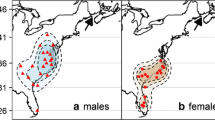Summary
A field study of the ranging behavior of post-fledging White-crowned Sparrows (Zonotrichia leucophrys nuttalli) was carried out in undisturbed natural habitat in the Point Reyes National Seashore, Marin Co., California, USA. Forty-three first-brood juveniles, with tail feathers still growing, were banded at an estimated average age of 27 days and re-trapped an average of an additional 24 days for a total minimum time in residence in the immediate natal area of 51 days (Table 1).
The distance from the site of first capture to subsequent recapture sites was about 60 m until age 35 days; then the distance increased to about 250 m by age 50 days (Fig. 2). These data indicate that the average juvenile White-crowned Sparrow completes at least the first 50 days of life in its natal area. Experimental work on song ontogeny has previously demonstrated that the sensitive period for song learning ends at about 50 days. Hence, young in our study population probably learn their natal dialect prior to any major dispersal movements. The correspondence between residence time and song learning would have the consequence of perpetuating song dialects as geographically structured populations.
Similar content being viewed by others
References
Baker MC (1975) Song dialects and genetic differences in white-crowned Sparrows (Zonotrichia leucophrys). Evolution 29:226–241
Baker MC, Marler P (1980) Behavioral adaptations that constrain the gene pool in vertebrates. In: Markl H (ed) Evolution of social behavior: Hypotheses and empirical tests. Dahlem Konferenzen. Verlag Chemic, Weinheim Deerfield Beach (Florida) Basel, pp 59–80
Baker MC, Mewaldt LR (1978) Song dialects as barriers to dispersal in White-crowned Sparrows, Zonotrichia leucophrys nuttalli. Evolution 32:712–722
Baker MC, Thompson DB, Sherman GL, Cunningham MA (1981a) The role of male vs male interactions in maintaining population dialect structure. Behav Ecol Sociobiol 8:65–69
Baker MC, Spitler-Nabors KJ, Bradley DC (1981b) Early experience determines song dialect responsiveness of female sparrows. Science 214:819–821
Baker MC, Mewaldt LR, Stewart RM (1981c) Demography of White-crowned Sparrows (Zonotrichia leucophyrs nuttalli). Ecology 62:636–644
Baker MC, Thompson DB, Sherman GL, Cunningham MA, Tomback DF (1982) Allozyme frequencies in a linear series of song dialect populations. Evolution (in press)
Berndt R, Sternberg H (1969) Über Begriffe, Ursachen und Auswirkungen der Dispersion bei Vögeln. Vogelwelt 90:41–53
Blanchard BD (1941) The White-crowned Sparrows (Zonotrichia leucophrys) of the Pacific seaboard: Environment and annual cycle. Univ Calif Publ Zool 46:1–178
Kluyver HN (1970) Regulation of numbers in populations of Great Tits (Parus m. major). In: Boer PJ den, Gradwell GR (eds) Proc Adv Study Inst Dynamics Numbers Popul (Oosterbeek). Centre for Agricultural Publication and Documentation (Pudoc). Wageningen, netherlands
Kroodsma DE, Pickert D (1980) Environmentally dependent sensitive periods for avian vocal learning. Nature 288:477–479
Lanyon WE (1979) Development of song in the Wood Thrush (Hylocichla mustelina), with notes on a technique for handrearing passerines from the egg. Am Mus Novit 2666:1–27
Lenington S (1979) Predators and blackbirds: The “uncertainty principle” in field biology. Auk 96:190–192
Marler P (1970) A comparative approach to vocal learning: song development in White-crowned Sparrows. J Comp Physiol Psychol 71:1–25
Marler P, Tamura M (1962) Song “dialects” in three populations of White-crowned Sparrows. Condor 64:368–377
Mewaldt LR, Archibald H (1966) Some home range measurements of ground-feeding birds at PRBO. Annu Rep Point Reyes Bird Observatory 1966:13–20
Mewaldt LR, King JR (1977) The annual cycle of Whitecrowned Sparrows, Zonotrichia leucophrys nuttalli, in coastal California. Condor 79:445–455
Mewaldt LR, King JR (1978) Latitudinal variation in prenuptial molt in wintering Gambel's White-crowned Sparrows. N Am Bird Bander 3:138–144
Milligan M, Verner J (1971) Inter-population song dialect discrimination in the White-crowned Sparrow. Condor 73:208–213
Munz PA, Keck DD (1959) A California flora. University of California Press, Berkeley, California
Petrinovich L, Patterson T, Baptista LF (1981) Song dialects as barriers to dispersal: a re-evaluation. Evolution 35:180–188
Shields WM (1982) Optimal inbreeding and the evolution of philopathry. In: Swingland IR, Greenwood PJ (eds) The ecology of animal movement. Oxford University Press, London (in press)
Author information
Authors and Affiliations
Rights and permissions
About this article
Cite this article
Baker, M.C., Sherman, G.L., Theimer, T.C. et al. Population biology of White-crowned Sparrows: Residence time and local movements of juveniles. Behav Ecol Sociobiol 11, 133–137 (1982). https://doi.org/10.1007/BF00300102
Received:
Accepted:
Issue Date:
DOI: https://doi.org/10.1007/BF00300102




